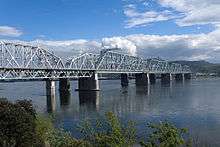Krasnoyarsk Bridge
Krasnoyarsk Railway Bridge in Krasnoyarsk, Siberia, carries the Krasnoyarsk Railway (part of the Trans-Siberian Railway) across the Yenisei River. It was originally a single-track truss bridge. The total length of the structure was 1 km, span width of 140 meters, the height of metal trusses in the vertex of the parabola was 20 meters.
History

The bridge was built by Russian workers and technicians under the supervision of professional engineer Evgeny Karlovich Knorre to a design by Professor of the Imperial Moscow Technical School Lavr Proskuryakov.[1] Construction started in 1895. Laying of the first stone took place on August 30, 1896. Participants in the ceremony of laying included the Yenisei governor, P.M. Preynne, E.K. Knorre, as well as railway authorities and the mass of urban dwellers.
The ceremony was essentially a prayer service, which was held by Akaki — bishop of Yenisei and Krasnoyarsk. A stone with a cross was placed in the lower area of an abutment pier, and a manuscript was laid on to it, which provided the information about the time of the laying, the names of the builders and the guests of honor. During the service, gold and silver coins were scattered around the stone, and then the first stone was closed by another one with cement grout.
The distinctive features of the Yenisei bridge were as follows: a total length of 907 meters, the largest trusses (144.5 meters) among all the built by that time in Russia,[2] a lightweight truss design, freezing of working shafts, the use of wood for caissons, lowering pressure within chambers, and most expensive construction — 3 million rubles.[2]
The construction was completed on March 28, 1899. Load tests on the bridge took place on 27 March. Initially, two trains consisted of four steam locomotives and six cars loaded with rails crossed the bridge. Then two steam locomotives hauling 23 platforms loaded with rails crossed the bridge at a speed of 70 km/h.
The structure received the Gold Medal at the Exposition Universelle (1900) by a special committee led by Gustave Eiffel.

When approved for the inscription on the World Heritage List in 2001, the bridge was described by the ICOMOS as "an early representation of a typical parabolic polygonal truss bridge in Russia", which became "a testing ground for the application of engineering theories and the development of new innovative solutions, which had numerous successors."[3] The local authorities, however, had it dismantled and replaced with a new bridge by 2007.
Renovation
In the 1930s, when a second track was being laid on the bridge in order to increase the capacity of the Trans-Siberian Railway, another structurally similar one was built nearby. In the 1990s, a construction of the third bridge was started alongside the existing ones. It was anticipated that after new bridge would open to traffic, the first pre-revolutionary one might be dismantled. In 2002, the dismantling of one of the most famous railway bridge in Russia was started, despite some protests of the defenders of cultural heritage. And on 7 August 2007, the old bridge was transferred for metal use.
References
- ↑ Часто источники ошибочно указывают автором проекта моста В.Г. Шухова
- 1 2 Переправы через Енисей | Эра красноярских мостов — строительный портал Sibdom.ru
- ↑ International Council on Monuments and Sites (2003). "Evaluations of Cultural Properties" (PDF). UNESCO World Heritage Committee. pp. 11–13.
Coordinates: 55°59′21″N 92°48′45″E / 55.9891°N 92.8124°E